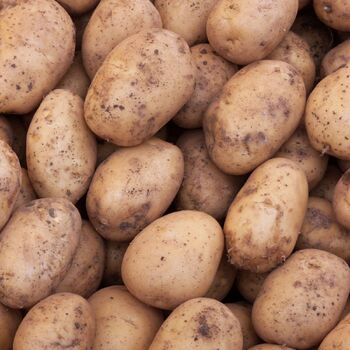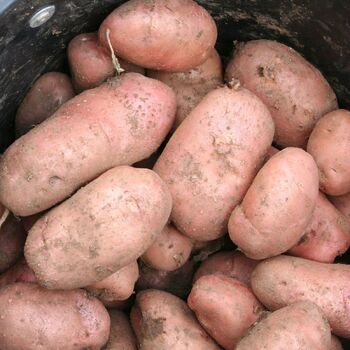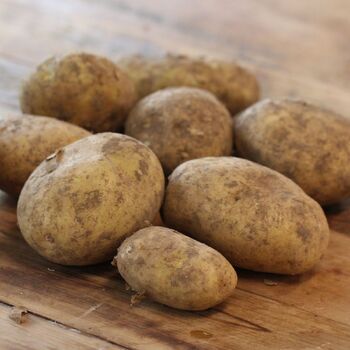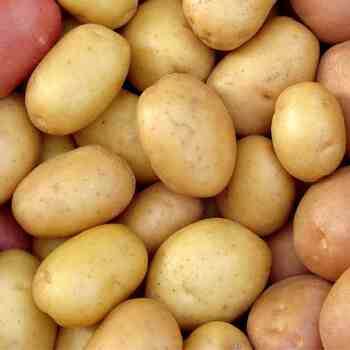
How to Grow Potato Tubers
Grow Guide #2306
Family: Solanaceae
Binomial name: Solanum tuberosum
Life Cycle: Perennial (usually grown as an annual)
This 'How to Grow' guide details everything a home gardener needs to know to plant, grow and care for Potatoes (Solanum tuberosum).
Potato varieties are classified as either indeterminate or determinate. Indeterminate potatoes produce tubers along their stems; stems should be covered as the plants grow to allow more tubers to be produced. Determinate potatoes produce tubers in a single layer underground; there's no need to cover their stems as they grow.
When to Plant Seed Potatoes
Potato is a warm season crop. Use the table below to identify the best time of year to plant seed potatoes in your climate.
| JAN | FEB | MAR | APR | MAY | JUN | JUL | AUG | SEP | OCT | NOV | DEC | |
|---|---|---|---|---|---|---|---|---|---|---|---|---|
| Cool | ||||||||||||
| Temperate | ||||||||||||
| Sub-Tropical | ||||||||||||
| Tropical | ||||||||||||
| Arid |
Preparation
Potato plants are best grown in full sun. Choose a location that will receive at least 6 hours of full sun each day.
Potato plants need a loose, well drained soil enriched with organic matter. Prepare soil by weeding it thoroughly, digging it over to at least a spade’s depth to loosen the soil, and adding aged animal manure or compost. Organic matter can be dug into heavy soil to lighten it so roots can grow freely. Keep the area free of weeds until planting. Learn more about preparing soil for planting here.
Potato plants are very susceptible to pests and diseases. Practice crop rotation to reduce the chance of pests and diseases becoming pervasive in your garden. Do not plant potatoes in the same position two years in a row. Read more about crop rotation here. Only plant certified seed potatoes; these potatoes have been tested to make sure they're free of disease.
Potato plants can be grown in containers or grow bags. Use a good quality potting mix and make sure your container is large enough for mature plants; a minimum of 40 litres is recommended for potatoes. During the growing season, keep in mind that container grown plants may need additional fertiliser to encourage healthy growth. Learn how to grow potatoes in containers and grow bags here.
Optional: Potatoes can be sprouted before they are planted by placing them in a single layer in a cool place for a few weeks. When sprouts are 2-3cm long, remove all but 2 or 3 strong shoots and plant the potatoes in the garden or a grow bag. This process is known as 'chitting'. Chitting can give potatoes a head start to the growing season, meaning they will mature earlier.
How to Plant Seed Potatoes in the Garden
- Make trenches 25cm wide and 20cm deep, piling up excess soil at the sides. Allow 60-75cm between trenches.
- Place potatoes in the trenches 25-30cm apart and backfill with about 10cm of soil.
- Water in well.
How to Grow Potatoes
Potato plants may need watering during the growing season. Water when the soil is dry about 5cm below the surface (test this by scratching away a little soil with your finger). Water deeply in the early morning or late afternoon. Avoid watering the leaves of plants to avoid fungal diseases. Learn more about watering here.
If soil was well prepared no extra fertiliser should be necessary. In poor soil or to give your plants an extra boost, application of a balanced fertiliser or one formulated for fruit and vegetables can be beneficial:
- Apply slow release fertiliser at the recommended rate when transplanting or when seedlings are 5-10cm tall.
- Apply liquid fertiliser at the recommended rate and frequency while plants are fruiting or flowering.
When the shoots are 15cm high, add more soil around the stems, leaving the top leaves exposed. As plants grow, continue to add soil or mulch around stems, unrolling the bag as you go, until the mounds are 30-40cm above the original soil level or the grow bag or container is nearly full.
Determinate varieties only: There is no need to mound the soil around the stems; when shoots are 15cm high apply a 10cm layer of organic mulch.
Potato is a frost sensitive crop. Do not plant until around 4 weeks before the last expected frost date for your region.
How to Harvest Potatoes
Potatoes should be ready to harvest in approximately 80-120 days.
Early or new potatoes can usually be harvested as soon as the plants start to flower. Dig up a sample to check for size before harvesting the entire crop. There's no need to harvest all your potatoes at once as they'll continue to grow and stay fresher in the ground than in storage.
For full-size potatoes, wait until plants have flowered and the foliage has fully died back, which is usually in late summer or early autumn. Use a garden fork to gently lift the tubers from the bed, shaking off any excess soil. Alternatively, you can ‘bandicoot’ the tubers gradually by digging carefully to unearth just a few tubers at a time. Potatoes can be eaten immediately or stored for future use. Store in a dark, cool well ventilated space, checking regularly for rot or sprouting.
Do not eat tubers that have green skin or shoots as they may be poisonous.
Common Problems when Growing Potatoes
Like all plants, potato is susceptible to some pests, diseases and other problems. Below is a list of the most common problems gardeners encounter when growing potato plants:
 Aphids are small (2-4mm long) sap-sucking insects that congregate on the new shoots or the undersides of leaves. They can cause leaves to wilt or become discoloured, and also excrete honeydew which can attract ants and other insect pests. To manage aphids, remove them by spraying with a garden hose, apply a soap or alcohol spray, or encourage predatory insects to your garden. Read more about aphids here.
Aphids are small (2-4mm long) sap-sucking insects that congregate on the new shoots or the undersides of leaves. They can cause leaves to wilt or become discoloured, and also excrete honeydew which can attract ants and other insect pests. To manage aphids, remove them by spraying with a garden hose, apply a soap or alcohol spray, or encourage predatory insects to your garden. Read more about aphids here. Onion thrips (Thrips tabaci) are flying insects less than 1.5mm long with slender pale yellow to light brown bodies. They suck sap from plants, leaving silver patches on the leaves and reducing the productivity and yield of plants. Thrips can live in the inner leaves and leaf folds of alliums, and may also infest bulbs. Wash thrips from affected plants using a garden hose, spread an organic mulch around plants, and encourage predatory mites and lacewings with companion planting.
Onion thrips (Thrips tabaci) are flying insects less than 1.5mm long with slender pale yellow to light brown bodies. They suck sap from plants, leaving silver patches on the leaves and reducing the productivity and yield of plants. Thrips can live in the inner leaves and leaf folds of alliums, and may also infest bulbs. Wash thrips from affected plants using a garden hose, spread an organic mulch around plants, and encourage predatory mites and lacewings with companion planting. Early blight (or Target Spot) is a fungal disease that attacks the leaves and stems of plants. Fungal spores are spread by wind, rain and insects. Circular brown or black spots, usually around 6mm in diameter, appear on the leaves and stems, lowering the productivity of plants. Grow only certified seed potatoes, spray affected plants with fungicide and practice crop rotation.
Early blight (or Target Spot) is a fungal disease that attacks the leaves and stems of plants. Fungal spores are spread by wind, rain and insects. Circular brown or black spots, usually around 6mm in diameter, appear on the leaves and stems, lowering the productivity of plants. Grow only certified seed potatoes, spray affected plants with fungicide and practice crop rotation. Potato Scab diseases are caused by bacteria or fungi that cause rough, raised patches or brown depressions on the skin of tubers. The pathogens may be present in the soil or carried on diseased seed potatoes. Inconsistent watering and soil that is alkaline can encourage scab diseases. Grow only certified seed potatoes, grow resistant varieties and practice crop rotation.
Potato Scab diseases are caused by bacteria or fungi that cause rough, raised patches or brown depressions on the skin of tubers. The pathogens may be present in the soil or carried on diseased seed potatoes. Inconsistent watering and soil that is alkaline can encourage scab diseases. Grow only certified seed potatoes, grow resistant varieties and practice crop rotation.%20(2).jpg) Rotten tubers are caused by pathogens entering tubers after sitting in cold, wet soil or being temporarily waterlogged. Tubers may show obvious signs of rot, have no roots or shoots, or produce stunted yellow leaves. Plant tubers in free-draining soil, raised garden beds or containers, and do not water them until shoots emerge. In heavy soils, lift and store tubers over winter and replant in spring.
Rotten tubers are caused by pathogens entering tubers after sitting in cold, wet soil or being temporarily waterlogged. Tubers may show obvious signs of rot, have no roots or shoots, or produce stunted yellow leaves. Plant tubers in free-draining soil, raised garden beds or containers, and do not water them until shoots emerge. In heavy soils, lift and store tubers over winter and replant in spring. Bacterial wilt is a disease that causes wilting, yellowing, stunting or die-back of plants. On tubers, wilt causes brown-grey patches on the skin and a discharge oozing from the eyes. The disease is spread through infected soil or water and enters the roots of plants where they have been damaged by tools or pests, often when soil conditions are wet. Grow only certified seed potatoes, dispose of infected plants in general waste and practice crop rotation.
Bacterial wilt is a disease that causes wilting, yellowing, stunting or die-back of plants. On tubers, wilt causes brown-grey patches on the skin and a discharge oozing from the eyes. The disease is spread through infected soil or water and enters the roots of plants where they have been damaged by tools or pests, often when soil conditions are wet. Grow only certified seed potatoes, dispose of infected plants in general waste and practice crop rotation.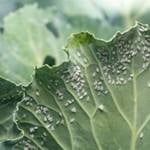 Whitefly is a sap-sucking insect related to aphids. They are often found in large numbers on the underside of leaves and will swarm in clouds when disturbed. Plants may have yellowing leaves or may wilt, and growth will be slowed. Whitefly can be removed with a garden hose or sprayed with soap spray. Badly affected plants should be destroyed. Attracting beneficial insects that will prey on whitefly can be beneficial. Read more about managing whitefly here.
Whitefly is a sap-sucking insect related to aphids. They are often found in large numbers on the underside of leaves and will swarm in clouds when disturbed. Plants may have yellowing leaves or may wilt, and growth will be slowed. Whitefly can be removed with a garden hose or sprayed with soap spray. Badly affected plants should be destroyed. Attracting beneficial insects that will prey on whitefly can be beneficial. Read more about managing whitefly here.


.png)



